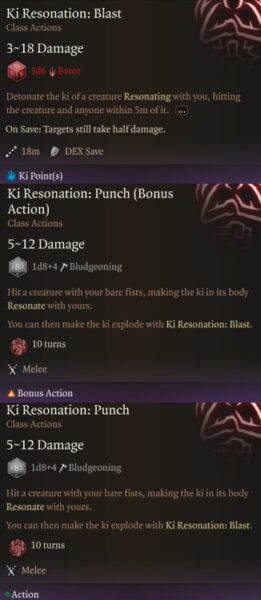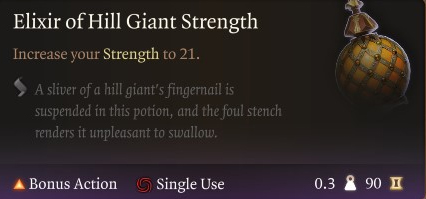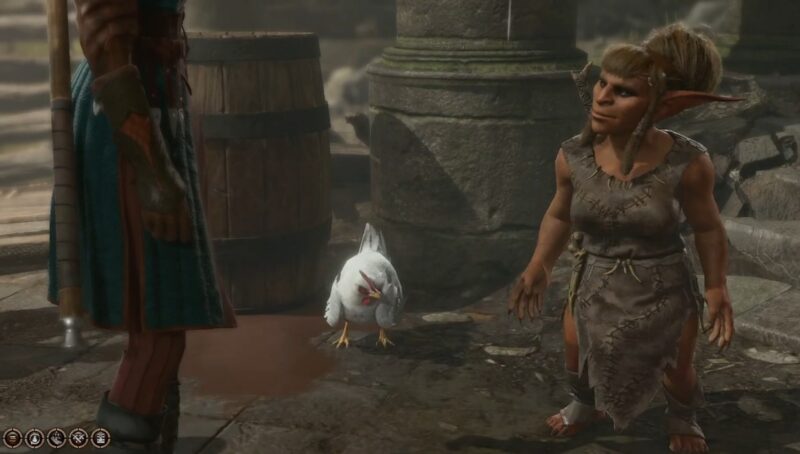This guide focuses on the best Monk build in Baldur’s Gate 3, the Way of the Open Hand subclass, and includes all components to build a powerful character.

- Patch 8 Changes for BG3
- Class Features & Mechanics
- Subclass
- Character Creation
- Level Progression
- Alternative Build
- Best Companions
- Best Gear
- Consumable Items and Potions
- Gameplay Tips and Tricks
- Monk Changes in Patch 7 for BG3
- Build Guide Summary
- What is the way of the open hand monk in Baldur’s Gate 3?
- How to open the wall in the open hand temple BG3?
- Is Monk Way of the Open Hand good?
This build page has been updated for the Patch 8 version of Baldur’s Gate 3.
Everything About the Way of the Open Hand Monk
The Way of the Open Hand Monk is a unique playstyle in Baldur’s Gate 3, using unarmed attacks and clothing for damage. Unlike every other class, the Monk doesn’t equip a weapon and relies on unarmed attacks, amplified from gloves for damage. The Monk also uses bonus actions and is best played with multiclassing for additional combat options.
The Way of the Open Hand Monk subclass gives the Monk build more bonus action utility. You can strike with bonus action and extra attack, giving you more per combat attacking power. The strength of the Monk is incredible damage, and mobility without the need for armor or weapons.
The Monk combat and gameplay focus on high movement speed, single target damage, and stuns. You greatly use your bonus actions and have multiple ways to deal with enemies. Furthermore, expect this build to excel at crowd control with high mobility for a melee build.
| Monk Class Pros | Monk Class Cons |
|---|---|
| Single Target Stuns | Low Health |
| High Mobility | Susceptible to Stuns |
| Multiple Attacks Per Turn | Limited Area Damage |
Patch 8 Changes to Way of the Open Hand Monk for BG3
Patch 8 brought significant updates to the Monk class in Baldur’s Gate 3, notably introducing the Way of the Drunken Master subclass. This new subclass focuses on erratic movement and disrupting enemies, offering enhanced mobility and crowd control. Abilities like “Drunken Technique” allow for swift evasions, while “Tipsy Sway” helps you avoid being pinned down, making the Monk a more agile and unpredictable force in combat.
While there are no major changes to the playstyle or build for the Way of the Open Hand Monk in BG3, we’ve included an alternative build below. This new option incorporates some multiclassing with Fighter to unlock Action Surge, adding a bit more versatility to your Monk’s combat options.
Monk Class Features & Mechanics

The following list presents class mechanics and features for Baldur’s Gate 3 Monk Way of the Open Hand Build:
- Primary Ability: Dexterity
- Saving Throw: Strength and Dexterity
- Weapon Proficiencies: Simple Weapons, Shortswords
- Armour Proficiencies: None
- Ki: resource points to use special Monk attacks.
- Flurry of Blows: punch twice in quick succession.
- Unarmored Defense: While not wearing armour, you add your Wisdom Modifier to your Armour Class.
- Dexterous Attacks: Attacks with Monk Weapons and unarmed attacks scale with your Dexterity instead of your Strength if your Dexterity is higher.
- Deft Strikes: Attacks with Monk Weapons and unarmed attacks deal 1~4 Bludgeoning damage, unless their normal damage is higher.
- Unarmed Strike: After making an attack with a Monk Weapon or while unarmed, you can make another unarmed attack as a bonus action.
The Monk build and mechanics are very different from typical melee builds. Your armor, with Unarmored Defense, gives AC for having high Wisdom. That’s why our ability score will reach 16 during character creation. It’s important to use “clothing” for this reason. Additionally, Dexterity NOT Strength increases our damage with melee attacks. Furthermore, there is another reason the ability score will look different than other builds. This is due to the two passives listed above. Consequently, it’s critical to reach 16 Dexterity and 16 Wisdom. The damage scaling is Dexterity based so we will look to increase that with feats later in character progression.
The Best Baldur’s Gate 3 Monk Way of the Open Hand build allows you to excel in ranged combat, control the battlefield, and adapt to various situations. It offers a versatile and exciting playstyle that can be highly rewarding, particularly for players who enjoy strategic combat and unique builds.
Monk Best Subclass – Way of the Open Hand

The Best Subclass for the Monk is Way of the Open Hand, with additional uses for our bonus action, extra stuns, and crowd control. With this subclass and a martial melee focus, the Monk will be able to strike multiple times per turn and control enemies with Flurry of Blows. In Baldur’s Gate 3, the Monk class offers various subclasses, each with its own unique abilities and strengths. At level three, you can make your decision on which to pick. Here’s a brief description of the monk’s subclasses and their strengths:
- Way of the Open Hand: Focuses on combat with bare hands. Unarmed but dangerous you control ki to heal or deal damage.
- Way of Shadow: Specialize in stealth and subterfuge often referred to as shadow dancers, great spies, and ninja characters.
- Way of the Four Elements: This spellcasting subclass uses elements, and knows them as their own body.
This Monk Build will focus on unarmed combat; thus the Way of the Open Hand subclass makes a perfect selection.
Character Creation
| Category | Selection |
|---|---|
| Character | Origin – Custom Character |
| Race | Wood Half-Elf |
| Racial Bonus | Civil Militia, Darkvision, Fey Ancestry |
| Class | Monk |
| Subclass | Way of the Open Hand |
| Background | Urchin |
| Ability Score | STR: 8 DEX: 16 CON: 15 INT: 8 WIS: 16 CHA: 10 |
| Skill Proficiencies | Acrobatics and Insight |
Recommended Background

Urchin is the best background for the Best Baldur’s Gate 3 Monk Way of the Open Hand Build Guide because it gives skill proficiency in Sleight of Hand and Stealth both are Dexertiy-based. Significantly, these two skills are high due to our ability score and help in dialogue and exploration. Background primarily plays a role in outside-of-combat dialogue and exploration checks. Below are our background recommendations:
- Urchin: Proficiency in Sleight of Hand (dexterity) and Stealth (dexterity). After surviving a poor and bleak childhood, you know how to make the most out of very little.
- Folk Hero: Proficiency in Animal Handling (wisdom) and Survival (Wisdom). You’re the champion of the common people, challenging tyrants and monsters to protect the helpless. Folk Hero companions are Wyll and Minsc.
- Entertainer: Proficiency in Acrobatics (dexterity) and Performance (charisma). You live to sway and subvert your audience, engaging common crowds and high society alike.
Related:
Race Choice for Baldur’s Gate 3 Monk Build

Wood Half-Elves are the best choice for the Best Baldur’s Gate 3 Monk Way of the Open Hand Build Guide because they get Civil Militia weapon proficiency, 12-meter Darkvision, and the best movement speed of all races. A secondary option would be the Githyanki because of Misty Step, Astral Knowledge, and Enhanced leap. This race also has incredible mobility, vital to a Monk’s survivability.
Here is the best race choice for a Way of the Open Hand Monk build in Baldur’s Gate 3:
| Wood Half-Elf | Githyanki |
|---|---|
| Darkvision | Astral Knowledge |
| Fey Ancestry | Githyanki Psionics |
| Fleet of Foot | Martial Prodigy |
The Monk’s racial choice will not influence ability score, but everyone should get a +2 and +1 to spend regardless. Thankfully, this frees your race choice up to not completely hinder yourself based on ability score, but race features. Each of these races offers unique advantages that can enhance your combat prowess, survivability, or utility. Additionally, consider the roleplaying opportunities and character concepts that resonate with you.
Recommended Skills for Monk Build

Acrobatics and Insight are the best skills for the Best Baldur’s Gate 3 Monk Way of the Open Hand Build Guide because they help resist being shoved, dialogue options, and exploration.
Here are the recommended skills for a Monk Way of the Open Hand:
- Acrobatics: Dexterity Skill that helps resist being shoved.
- Insight is a Wisdom skill used in dialogue and exploration.
Remember that proficiency in skills can be gained through your choice of background in Baldur’s Gate 3. Consider your character concept and the role you want to play in the party when selecting skills to specialize in.
Best Monk Ability Scores

The best ability score for the Best Baldur’s Gate 3 Monk Way of the Open Hand Build Guide is 16 Dexterity, 16 Wisdom, and 15 Constitution. You can lower Strength and Intelligence to 8 because you won’t need it with this build, while Charisma is kept at 10. Strength can be increased to 23 or 27 with Elixirs that last until a long rest, thus you want it lower to free up a higher score.
Below is a chart for the best ability score for a Way of the Open Hand Monk in Baldur’s Gate 3:
| Ability Score | Points Goal |
|---|---|
| Strength | 8 |
| Dexterity | 16 |
| Constitution | 15 |
| Intelligence | 8 |
| Wisdom | 16 |
| Charisma | 10 |
For this build, we recommend 15 Constitution and will reach 16 with a feat at level 4 (Tavern Brawler). Typically you don’t want odd numbers, because only even numbers improve your rolls (saving and attack). However, very early on we will reach 16. Make sure to check out our Permanent bonus guide on how you can boost your ability score through quests.
Strength Ability Score & Monk
Strength is also important due to the Tavern Brawler feat which we will select at level 4. However, we use the Elixir of Hill Giant Strength which increases our strength to 21 passively. This allows you to gain a higher ability score, without having to spend points on strength. Keep in mind, that you will need to constantly craft, buy, and consume Hill Giant (or Cloud Giant) strength elixirs which last until a long rest.
Consider the ability score loadout geared towards optimal damage on higher difficulty and we assume you will use Hill Giant elixirs on tough encounters.
Monk Illithid Powers

Illithid Powers are unlocked later in the game when you learn more about the Mind Flayers and tadpoles. You can gain jars of Mind Flayer Parasite Specimens, and consume them to gain one point. Consequently, this is essentially another skill tree advancement with some very strong powers. If you decide to advance this skill line, these are the choices we suggest.
Here are the best Illithid Powers for the Monk Build:
| Illithid Powers | Description |
|---|---|
| Psionic Dominance | When an enemy within 18m targets you with a spell of a Level that is lower than or equal to your Proficiency Bonus, you can use your reaction to nullify the spell. The passive feature helps against spell casters. |
| Shield of Thralls | Conjure a volatile shield around yourself or an ally, granting the target 10 temporary hit points. If these temporary hit points are lost due to incoming damage, the shield bursts, possibly Stunning nearby foes. This can be a useful defensive shield when expecting or taking pressure. |
| Psionic Backlash | When an enemy within 9m casts a spell, you can use your reaction to inflict ld4 Psychic damage to the caster per the spell’s level. |
| Repulsor | Massive area knockback that can hit friendlies. |
| Charm | This is the priority power you want to obtain because you can force enemies to attack something else. |
Monk Level Progression
| Level | Class | Selection |
|---|---|---|
| 1 | Monk | Ki, Unarmored Defense, Dexterous Attacks |
| 2 | Monk | Unarmoured Movement, Patient Defense, Step of the Wind |
| 3 | Monk | Subclass: Way of the Open Hand |
| 4 | Monk | Feat: Tavern Brawler |
| 5 | Monk | Extra Attack, Stunning Strike |
| 6 | Monk | Improved Unarmoured Movement, Ki Empowered Strike, Wholeness of Body |
| 7 | Monk | Evasion, Stillness of Mind |
| 8 | Monk | Feat: Ability Improvement Dexterity |
| 9 | Monk | Ki Resonation Punch, Ki Resonation Blast |
| 10 | Rogue | Acrobatics and Sleight of Hand |
| 11 | Rogue | Cunning Actions |
| 12 | Rogue | Subclass: Thief |
Alternative Way of the Open Hand Monk Build
In our alternate Monk multiclass build, we suggest starting with the Way of the Open Hand and later adding Rogue to create a swift, high-damage fighter. However, this time we’re also incorporating two levels of Fighter at the end. While this setup costs you one feat, the trade-off is well worth it for gaining Action Surge, which is an incredibly valuable ability that grants you an extra action once per Short Rest. When paired with a Potion of Speed or Haste, this lets your Monk unleash a brutal second round of attacks, turning the tide of battle with a flurry of strikes.
| Level | Class | Selection |
|---|---|---|
| 1 | Monk | Ki, Unarmored Defense, Dexterous Attacks |
| 2 | Monk | Unarmoured Movement, Patient Defense, Step of the Wind |
| 3 | Monk | Subclass: Way of the Open Hand |
| 4 | Monk | Feat: Tavern Brawler |
| 5 | Monk | Extra Attack, Stunning Strike |
| 6 | Monk | Improved Unarmoured Movement, Ki Empowered Strike, Wholeness of Body |
| 7 | Rogue | Skill Proficiency: Stealth, Sleight of Hand Skill Expertise: Stealth, Sleight of Hand |
| 8 | Rogue | Cunning Actions |
| 9 | Rogue | Subclass: Thief |
| 10 | Rogue | Feat: Alert |
| 11 | Fighter | – |
| 12 | Fighter | Action Surge |
Level 1

At Level one follow our character creator to pick all correct background, race, skills, and ability distribution, focusing on Dexterity and Wisdom. At Level 1, the Monk unlocks Flurry of Blows. Punch twice in quick succession. This will be your primary damage source and can use it as a bonus action. Moreover, you can use an action for a weapon attack and Flurry of Blows for an additional attack even at level one. Additional passives granted at Level 1 as a Monk:
- Ki: resource points to use special Monk attacks can be replenished on short rest.
- Unarmored Defense: While not wearing armour, you add your Wisdom Modifier to your Armour Class. This is why we want high Wisdom and only use clothing not armor unless it gives more Armour Class (AC).
- Dexterous Attacks: Attacks with Monk Weapons and unarmed attacks scale with your Dexterity instead of your Strength if your Dexterity is higher. This is the reason our primary offense stat is Dexterity, not Strength.
- Deft Strikes: Attacks with Monk Weapons and unarmed attacks deal 1~4 Bludgeoning damage, unless their normal damage is higher.
- Unarmed Strike: After attacking with a Monk Weapon or while unarmed, you can make another unarmed attack as a bonus action.
You will get your subclass at level 3, so don’t expect it during character creation. The gameplay at the start is very simple, charge in and attack with unarmed attack, and Flurry with bonus action. Stick to Clothing, not armour so you can take advantage of your passive AC.
Way of the Open Hand Monk Gameplay & Priorities
During the early stages of BG3, look to just unarmed attacks for damage without the need to equip any weapons. Your main challenge will be mobility, though through leveling you will get increased mobility options. Additionally, your primary goal should be to equip the Haste Helm as soon as possible. Moreover, look to acquire the Elxir of Hill Giant Strength, Elixir of Bloodlust, or Potion of Invisibility. Bloodlust helps trigger an extra action on kill and Invisibility helps you stay alive if you’re in trouble.
Your overall priority with the Way of the Open Hand Monk build is the following:
- Complete Prologue
- Recruit Companions
- Unlock Withers, respec companions to proper class/ability score
- Collect the Necromancy of Thay (important in Act 3)
- Reached Hollowed City/Druid Grove
- Sell, Stock up, complete quests
- Unlock summons, Scratch, Shovel
- Progress to level 5
- Reach Underdark and Grymforge
- Check all Permanent Bonuses in Act 1 and the best Gear
- Act 1 Checklist for step-by-step completion
Following these steps ensures a strong foundation, especially if you plan on playing solo or on Honour Mode difficulty.
Level 2

At Level 2, the Monk unlocks a lot of class features and actions including an additional Ki point. Here’s what to expect as a Level 2 Monk:
- Unarmoured Movement: Your movement speed increases by 3m while you are not wearing armor or using a shield.
- Patient Defense: using a bonus action and a Ki Point, Attack Rolls against you have Disadvantage, and you have Advantage on Dexterity Saving Throws.
- Step of the Wind: Dash (Action): using a bonus action and a Ki point, Double your movement speed. Jump no longer requires a bonus action.
- Step of the Wind: Disengage (Action): using a bonus action and a Ki point, Retreat to safety by Disengaging. Jump no longer requires a bonus action.
If we unpack these additional class features and actions, it gives us more incentive to use clothing not armor due to the movement speed increase. With Patient Defense, you can give a disadvantage. This forces the enemy to roll two d20s and take the lowest. It gives you a big offensive and defensive advantage against an enemy. You will also have much higher mobility with Step of the Wind Dash and Disengage. The Dash in particular is extremely useful because it can be used as a bonus action.
Combat at this point remains the same, except throwing in a Patient Defensive when you need protection or a big hit against an enemy.
Level 3

At Level 3, we will select the Way of the Open Hand Monk subclass. This will unlock the following:
- Open Hand Technique: manipulate Ki’s Energy to add additional effects to Flurry of Blows.
- Deflect Missiles: Use your reaction to reduce the damage from a ranged weapon attack.
What this does is essentially morph our Flurry of Blows into three different forms. Stagger: to stagger an enemy; Push: to knockback; and Topple: to knock over in Prone. Each still costs a bonus action, rather than an action. This allows you to control the enemy, primarily I use Topple and Push. Furthermore, Prone is a great status effect that essentially takes a turn away from an enemy. You want to use this constantly or knock-off ledges with Push.
Level 4
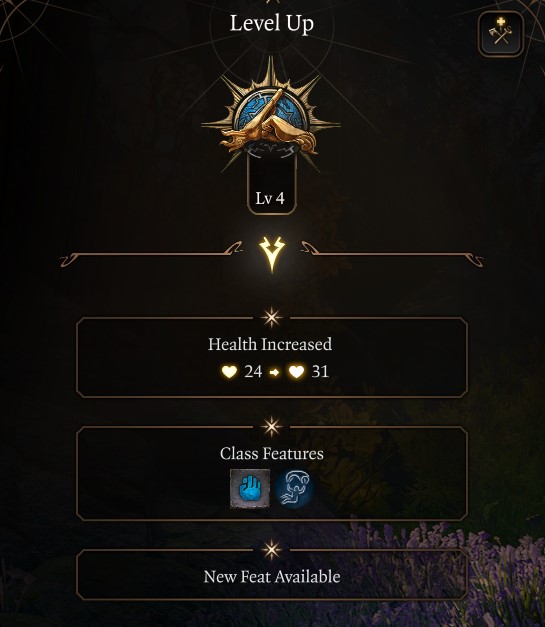
At Level 4, you get to pick a Feat along with a Ki Point and Slow Fall. Let’s break down what to do and why.
- Slow Fall: When you fall, you can use your reaction to gain Resistance to Falling damage.
Tavern Brawler Feat: When you make an unarmed attack, use an improvised weapon, or throw something, your Strength Modifier is added twice to the damage and Attack Rolls. Also, lets you choose a +1 ability score in Strength or Constitution. With our +1 selection, we will reach 16 Constitution giving us an even number and more health. The picture shows 14, however, this was an earlier build template that had a lower constitution. This will help us do more damage with Strength. At this point, Elixirs of Hill Giant Strength becomes very important to add a ton of damage.
Now Strength becomes a very powerful ability score giving a 2x bonus to damage and attack rolls. You want to look for gear sets like Mighty Cloth or potions like Elixir of Hill Giant Strength. The benefit of Hill Giant’s strength is it lasts until a long rest. Therefore, look to consume this potion as a buff for hard fights after your long rest. This will radically increase your damage, and it only gets better next-level Extra Attack with the Best Baldur’s Gate 3 Way of Open Hand Monk Build.
Level 5
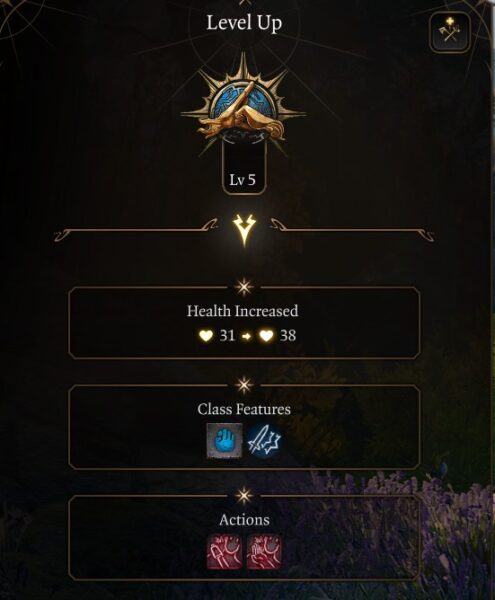
As a Level 5 Monk, our power dramatically increases via a new class feature along with some extra utility.
- Extra Attack: can make an additional free attack after making an unarmed or weapon attack.
- Stunning Strike (Melee): use action to possibly stun the target.
- Stunning Strike (Unarmed): use action to possibly stun the target.
You can now use an action and a bonus action to stun a target. This gives the Monk tons of single-target crowd control, and if you miss attempt number one you can try again. You get two attacks with one action thanks to Extra Attack and can still use a bonus action for another attack. This opens up a lot of offensive possibilities. The easiest thing to do is target the hardest-hitting enemy and simply lock them down with constant stuns, knockback, and prone status effects.
Level 6
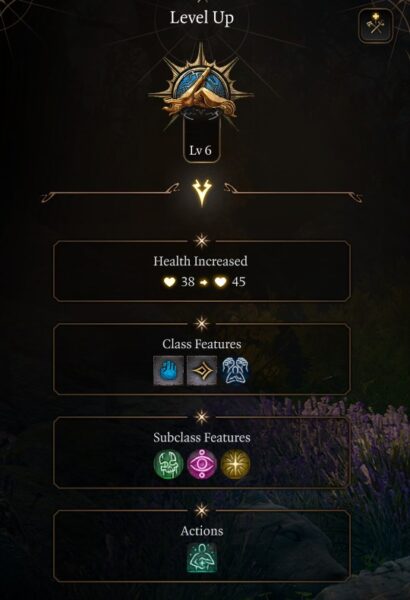
At Level 6, expect even more to unlock for your class and subclass.
Here’s the breakdown of the Monk at level 6 in Baldur’s Gate 3:
- Improved Unarmoured Movement: Your movement speed increases by 4.5m while you are not wearing armor or using a shield.
- Ki Empowered Strikes: Your unarmed attacks count as magical to overcome enemies’ Resistance and Immunity to non-magical damage.
- Manifestation of Body: Your unarmed attacks deal an additional 3-6 Necrotic damage.
- Manifestation of Mind: Your unarmed attacks deal an additional 3-6 Psychic damage.
- Manifestation of Soul: Your unarmed attacks deal an additional 3-6 Radiant damage.
- Wholeness of Body: Heals for 18 Regain half your Ki Points and have a bonus action for 3 turns.
To summarize the changes, you get additional benefits from not using armor for movement speed purposes. You get a bit more damage on unarmed attacks. The biggest change is Wholeness of Body, giving you a bonus action for 3 turns. It does cost an action to use, but heals, gives Ki Points, and more offensive potion for a few turns.
Gameplay: It’s smart to use Wholeness of Body when you aren’t able to reach an opponent or turn one when you want extra attacks for the duration of a longer fight. Also, make sure to activate one of the Manifestations for passive damage increase. This will be off by default, and your toolbar under passives you can activate it for more damage.
Ending Act 1 as a Way of the Open-Hand Monk
Upon reaching Level 6, you should be close to the completing Act 1 content. Be sure to stop at traders and buy up needed camp and alchemy supplies. Additionally, make sure to look over what the best Act 1 items are. Furthermore, make sure you haven’t missed out on the permanent bonuses you can find in Act 1. Moreover, the Grymforge has powerful armor and weapons (Adamantine) which can be used well into Act 3. Consider taking the time to collect the Mithral, Mould, and Craft items before moving on to Act 2. The game will alert you when this is about to happen, but once you move onto the Shadow-Cursed Lands you can’t go back.
Finally, look to acquire the Elixir of Hill Giant Strength and Potion of Speed. You can combine these two for huge damage increases and your Way of the Open Hand Monk will feel very powerful immediately.
Level 7

As a Level 7 Monk, you unlock more Ki points and some defensive class features.
- Evasion: When a spell or effect would deal half damage on a successful Dexterity Saving Throw, it feels no damage if you succeed, and only half damage if you fail.
- Stillness of Mind: If you are Charmed or Frightened, you automatically cast Stillness of Mind to remove the condition.
The gameplay remains the same at this level, just with more defensive capabilities.
Level 8
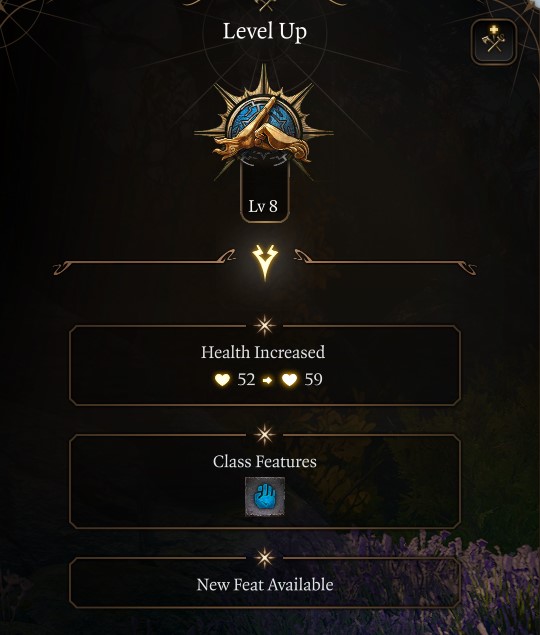
At Level 8, you get another feat selection and I suggest taking the Ability Improvement.
- Ability Improvement Dexterity: Increase your Dexterity to +2 which will help with damage. This will be the last feat we take for this build, but ability improvements are always solid choices and it’s harder to increase Dexterity than say Strength due to consumables.
Hitting 18 in Dexterity means big damage, a higher percentage to hit, and zero complex gameplay mechanics.
Level 9
At Level 9 the Way of the Open Hand Monk unlocks one more Ki Point, 3 subclass features, and Advanced Unarmoured Movement.
Advanced Unarmoured Movement (class feature): Difficult Terrain doesn’t slow you down and you can Jump an additional 6m while you are not wearing armour or using a shield.
- Ki Resonation Punch (subclass Feature): Hit a creature with your bare fists, making the ki in its body Resonate with yours.
- Ki Resonation Punch Bonus Action (subclass Feature): Hit a creature with your bare fists, making the ki in its body Resonate with yours.
- Ki Resonation Blast (subclass Feature): Detonate the ki of a creature Resonating with you, hitting the creature and anyone within 5m of it.
This is where the Monk starts to get interested in Ki Resonation. Think of the Punch as either an action or a bonus action as a “debuff.” You essentially mark the target with Resonation and then can activate Ki Resonation Blast (which doesn’t cost an action or a bonus action) to blow up the target with force damage. It also has a 5m area damage component to us, solving one of the build weaknesses up until this point.
Ideally, you’d want to spend a bonus action on this vs an action because the Resonation Punch damage is somewhat weaker than your normal action-based attacks. Consider using one of these attacks either with an extra attack or bonus action to mark the target then explode them without using an action or reaction!
Level 10
We have three more levels to go with the Monk and we need to make an important decision. For the next three levels, the Monk only gets a movement passive and another one when you long rest, and at max level 12, a feat. Consequently, in the grand scheme of the build’s performance, this is minimal improvements. What I suggest at this point is to multi-class the last three levels to get another bonus action.
The Thief Rogue with 3 levels will give you the following:
- Sneak Attack: (not useful for this build)
- Cunning Action Hide, Dash or Disengage
- Fast Hands (two bonus actions)
- Second-Story Work (Resistance to fall damage)
When you hit max level with this build, you would then be able to attack twice with your action and use two bonus actions giving you four attacks in one turn. The two alternatives are Fighter for Action Surge, but that isn’t every turn just one more action per short rest. Or you can remain in the Monk level until 12. I highly suggest switching because the Monk craves another bonus action and the game’s combat revolves around actions and bonus action resources.
You can amplify two skills, which I recommend Acrobatics and Sleight of Hand if you use this Monk in replacement for a Rogue or Ranger.
Level 11
Level 11 will seem a bit lackluster because our bonus action won’t be used for hiding or running away but it will get much more useful at level 12. The second level in Thief gives you:
- Cunning Action Hide: Hide from enemies by succeeding Stealth checks. Stick to the dark and avoid enemy sightlines. Attacking or casting a spell will reveal your location.
- Cunning Action Dash: Cover more distance this turn: double your Movement Speed.
- Cunning Action Disengage: Retreat safely: moving won’t provoke Opportunity Attacks.
The benefit of Cunning Action is having Dash be a bonus action rather than an Action. This allows you to use the bonus action and cover a massive distance with the Monk’s high movement speed.
Level 12
Finally, you’ve reached max level 12 in Baldur’s Gate 3 as a Monk, congratulations! With three levels into Rogue, we want to take another level in the Thief Subclass giving us Fast Hand and an extra bonus action. Consequently, now each turn if you attack with your action, you should get two attacks, two bonus actions for four in total!
Best Companions for Monk Build
The best companion for the Best Baldur’s Gate 3 Monk Way of the Open Hand Build Guide is Lae’zel because she’s a melee-focused damage dealer. When you combine the Monk and another front-line fighter in cooperation the pressure and crowd control on the group is great.
- Lae’zel (Fighter): damage, crowd control, and in-your-face aggression.
- Shadowheart (Cleric): buffs, healing, and control.
- Gale (Wizard): Used for area base damage, crowd control, and range.
It’s important to note that party composition and synergy play a significant role in determining the effectiveness of your companions. Additionally, consider the strengths and weaknesses of each companion and how they align with your main character’s abilities and playstyle.
Best Gear for Baldur’s Gate 3 Monk Build
In Games like Baldur’s Gate 3, you’ll explore the world, loot chests and your enemies’ dead bodies, and complete quests, and all those activities can reward you with useful items, potions, armour, weapons, scrolls, and much more. There are three Acts in BG3, and Best Baldur’s Gate 3 Way of the Open Hand Guide includes suggested sets and alternatives for Act 1 and Act 3.
Beginner: Starting the Game
Here’s the best beginner gear for the Best Baldur’s Gate 3 Monk Way of the Open Hand Build Guide:
| Gear Slot | Best Gear Item | Effect |
|---|---|---|
| Head | Haste Helm | Increased Movement |
| Cape | – | |
| Chest | Armour of Uninhibited Kushigo | Defense |
| Gloves | Gloves of Cinder and Sizzle | Fire Damage |
| Boots | Disintegrating Night Walkers | Mobility |
| Necklace | Amulet of Misty Step | Misty Step |
| Ring | Crusher’s Ring | Increased Movement |
| Ring | Sunwalker’s Gift | Darkvision |
| Weapon 1 Main Hand | Unarmed | – |
| Weapon 2 Ranged | Bow of Awareness | +1 Initiative Roll |
Below is the Best Act 1 Armour, Weapons, and Equipment for the Way of the Open Hand Monk in BG3:
- Haste Helm: Chest in the Blighted Village X 32, Y 403 (Alternative Cap of Wrath).
- Armour of Uninhibited Kushigo: Find the Missing Boots quest reward from Sergeant Thrinn in Grymforge Act 1 (Alternative The Protecty Sparkswall, or Bloodguzzler Garb).
- Gloves of Cinder and Sizzle: Sold by Lady Esther at Rosymorn Monastery Trail (Alternatives The Sparkle Hands, or Bracers of Defence).
- Disintegrating Night Walkers: Dropped by True Soul Nere at the Grymforge (Alternatives Boots of Genial Striding, or Boots of Striding).
- Amulet of Misty Step: Chest behind the ogre Polma in the Defiled Temple within the Goblin Camp (Alternatives Moondrop Pendant, Amulet of Branding, or Amulet of Restoration).
- Crusher’s Ring: Can be looted or stolen from Crusher in the Goblin camp (Alternatives Ring of Flinging, or Fetish of Callarduran Smoothhands).
- Sunwalker’s Gift: Buy it from Blurg in Myconid Colony in the Underdark (Alternatives Ring of Absolute Force, or The Sparkswall).
- Unarmed: Damage comes from gloves, not weapons.
- Bow of Awareness: Sold by Roah Moonglow in the Shattered Sanctum.
Advanced: End-Game
The following table presents the best advanced and end-game gear for the Best Baldur’s Gate 3 Monk Way of the Open Hand Build Guide:
| Gear Slot | Best Gear Item | Effect |
|---|---|---|
| Head | Mask of Soul Perception | +2 Attack Roll |
| Cape | Fleshmelter Cloak | Acid Damage |
| Chest | Vest of Soul Rejuvenation | Unarmed Strike |
| Gloves | Gloves of Soul Catching | Unarmed Damage |
| Boots | Boots of Uninhibited Kushigo | Wisdom Modifier |
| Necklace | Surgeon’s Subjugation Amulet | Stun on Crit |
| Ring | Killer’s Sweetheart | Auto Crit |
| Ring | Ring of Regeneration | Free Healing |
| Weapon 1 Main Hand | Unarmed | – |
| Weapon 2 Ranged | Darkfire Shortbow | Fire & Cold Resistance |
| Throwable | Nyrulna | Throwable Damage |
Below are the Best Act 3 Armour, Weapons, and Equipment for the Way of the Open Hand Monk in BG3:
- Mask of Soul Perception: The upstairs room at the Devil’s Fee, locked in a Gilded Chest in Act 3 (Alternatives Horns of the Berserker, or Helldusk Helmet).
- Fleshmelter Cloak: Found in the House of Healing Morgue (Alternatives Cloak of Protection).
- Vest of Soul Rejuvenation: Can be purchased from Sorcerous Sundries in Act 3 (Alternatives The Graceful Cloth, or The Mighty Cloth).
- Gloves of Soul Catching: Save Hope in the House of Hope (Alternatives Helldusk Gloves, Gauntlet of the Tyrant, or Seraphic Pugilist Gloves).
- Boots of Uninhibited Kushigo: Dropped by Prelate Lir’i’c in Astral Plane ending Act 2 (Alternatives Helldusk Boots, or Disintegration Night Walkers).
- Surgeon’s Subjugation Amulet: Looted from Malus Thorm at the House of Healing in Act 2 (Alternatives Amulet of Greater Health, or Sentient Amulet).
- Killer’s Sweetheart: Found inside the Gauntlet of Shar ( X: -833 Y: -729). (Alternative Shifting Corpus Ring).
- Ring Of Regeneration: Sold by Rolan at Sorcerous Sundries (Alternative Ring of Free Action).
- Darkfire Shortbow: Sold by Dammon in the Last Light Inn.
- Nyrulna: Stole from Akabi in Circus of the Last Days in Rivington Act 3.
Best Consumable Items and Potions
Consumables are items that can be used once and then destroyed. Typically, they are used to restore health or other resources. Some common types of consumables include potions, scrolls, food, drinks, and arrows.
The following list represents the best individual use consumable items that will aid in our Best Baldur’s Gate 3 Monk Way of the Open Hand Build Guide:
- Elixir of Hill Giant Strength: Increases Strength ability score to 21 until Long Rest.
- Potion of Speed: Gain extra action, +2 AC, Advantage on Dexterity Saving Throws, and double movement speed.
- Elixir of Bloodlust: Once per turn when you kill a foe, you gain HP 5 temporary hit points and an additional action.
- Drow Poison: Weapon poison that adds Constitution Saving Throw or becomes Poisoned and falls Asleep.
- Potion of Flying: Drink to gain a flying speed of 60ft for one hour.
- Elixir of Heroism: Gain 10 temp HP and become Blessed until a long rest.
- Potion of Greater Healing: 4d4 + 4 hit points restored.
- Oil of Accuracy: Coat Weapon. Bonus of +2 in Attack Rolls.
- Elixir of Vigilance: Drink to gain a +5 bonus to Initiative and you can’t be Surprised.
- Elixir of Darkvision: (only non-Darkvision race): Drink to gain the ability to see in the dark up to 12m.
Monk Gameplay Tips and Tricks
Here is a list of 10 gameplay, combat, tips, and tricks when playing the Monk in Baldur’s Gate 3:
- Mobility: Monks have one of the highest movement speeds for a melee build so take advantage of it offensively and defensively.
- Bonus Actions: make sure to use your bonus action every turn for an extra attack or utility.
- Stuns: the Monk excels at single-target crowd control, and in later levels, you can make multiple attempts.
- Armor: make sure to use clothing not light, medium, or heavy armor as it’ll destroy your mobility.
- Weapons: stick to unarmed attacks for maximum damage.
- Consumables: Using a potion of speed gives you a secondary action for 3 turns and is very helpful.
- Wholeness of Body: use this skill early during long-duration fights for 3 extra turns of bonus action.
- Ki Points: make sure to refresh these points after combat so you don’t run out during each encounter.
- Opening Turn: attempt to reach a target for attack or use bonus action for double movement speed.
- Throw: you can throw objects when not in melee range to help keep damage high.
Remember, this build guide serves as a foundation, and you can always adapt it to suit your preferences and the needs of your campaign. Enjoy playing as a formidable Way of the Open Hand Monk!
Monk Changes in Patch 7 for BG3

While Patch 7 changed many aspects of BG3, the Monk build, combat, and gameplay remain relatively the same. On September 5th, 2024, Patch 7 for Baldur’s Gate 3 was released, bringing a massive update to the game. The developers added 13 new cinematic scenes, including some new battle sequences with the Netherbrain. The Honour Mode is also getting enhancements, with more legendary actions added to existing bosses, making the game more challenging.
The Monk build, gear and playstyle remains the same in Patch 7. The main focus was mods, and handing the content of to creators for future gameplay.
Best Baldur’s Gate 3 Monk Way of the Open Hand Build Guide Summary
Subclass: Way of the Open Hand
Armor: Clothing
Weapons: Unarmed
Background – Urchin
- Strength – 8
- Dexterity – 16
- Constitution – 15
- Intelligence – 8
- Wisdom – 16
- Charisma – 10
Level Progression
- Level 1 – Flurry of Blows
- Level 2 – Unarmoured Movement
- Level 3 – Way of the Open Hand Subclass
- Level 4 – Tavern Brawler Feat
- Level 5 – Extra Attack
- Level 6 – Ki Empowered Strikes
- Level 7 – Evasion
- Level 8 – Dexterity +2
- Level 9 – Advanced Unarmoured Movement
- Level 10 – Multiclass to Rogue
- Level 11 – Cunning Actions
- Level 12 – Fast Hands
Frequently Asked Questions
What is the way of the open hand monk in Baldur’s Gate 3?
The Way of the Open Hand Monk is the best pure martial Monk subclass in BG3 as it features impressive control, knockbacks, and pressure.
How to open the wall in the open hand temple BG3?
To open the hidden wall in the Open Hand Temple in BG3, you need to complete the murder mystery queest from Act 1.
Is Monk Way of the Open Hand good?
Yes, The Way of the Open Hand Monk is one of the best sublcass in the game if you want to experience pure martial gameplay.
Looking For More About Baldur’s Gate 3?
Thank you for reading Best Baldur’s Gate 3 Monk Way of the Open Hand Build Guide Guide. We provide the latest news and create guides for Baldur’s Gate 3. Also, watch me play games on Twitch or visit my YouTube channel!
 Reddit
Reddit
 Email
Email



